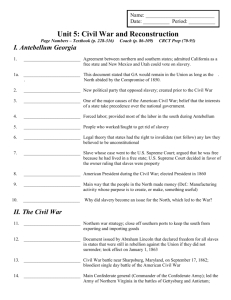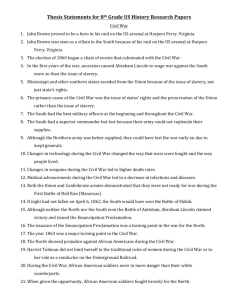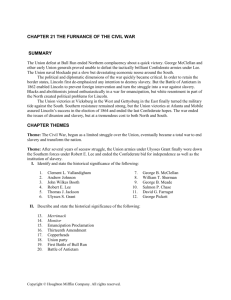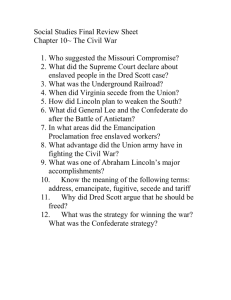ch.4 civil war test
advertisement
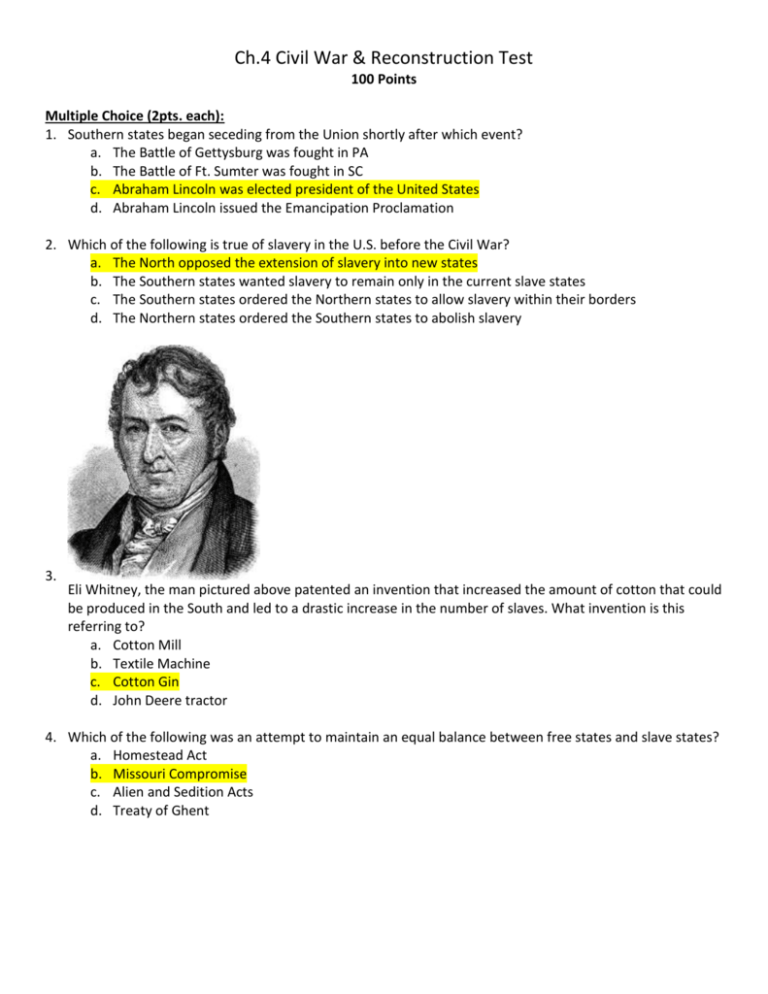
Ch.4 Civil War & Reconstruction Test 100 Points Multiple Choice (2pts. each): 1. Southern states began seceding from the Union shortly after which event? a. The Battle of Gettysburg was fought in PA b. The Battle of Ft. Sumter was fought in SC c. Abraham Lincoln was elected president of the United States d. Abraham Lincoln issued the Emancipation Proclamation 2. Which of the following is true of slavery in the U.S. before the Civil War? a. The North opposed the extension of slavery into new states b. The Southern states wanted slavery to remain only in the current slave states c. The Southern states ordered the Northern states to allow slavery within their borders d. The Northern states ordered the Southern states to abolish slavery 3. Eli Whitney, the man pictured above patented an invention that increased the amount of cotton that could be produced in the South and led to a drastic increase in the number of slaves. What invention is this referring to? a. Cotton Mill b. Textile Machine c. Cotton Gin d. John Deere tractor 4. Which of the following was an attempt to maintain an equal balance between free states and slave states? a. Homestead Act b. Missouri Compromise c. Alien and Sedition Acts d. Treaty of Ghent 5. The picture above illustrates a network of routes that allowed many escaped slaves flee to freedom. What is this network referred to as? a. Underground Railroad b. Oregon Trail c. Trail of Tears d. Santa Fe Trail 6. Which statement best describes the Confederate economy? a. The Confederate economy was primarily agricultural. b. The Confederate economy was primarily split between agriculture and manufacturing. c. The Confederate economy was primarily based on the cattle industry. d. The Confederate economy was primarily based on the manufacturing industry. 7. Which event took place less than a week after Robert E. Lee’s surrender to Ulysses S. Grant? a. Secretary of State William Seward purchased Alaska from Russia b. President Abraham Lincoln was re-elected to his second term c. President Abraham Lincoln was assassinated by John Wilkes Booth d. The 13th Amendment, which abolished slavery in the U.S. was ratified 8. Which of the following refers to a major difference between the North and the South prior to the Civil War? a. Culture b. Economy c. Geographic d. All of the above 9. 10. The man pictured above led a raid against Harper’s Ferry, VA in 1859 with hopes of seizing the federal arsenal and leading a slave rebellion. Who is he? a. John C. Calhoun b. Robert E. Lee c. John Brown d. Stephen Douglas The map above shows the Confederate States of America. Which of the following was the first to secede from the Union? a. North Carolina b. Nebraska c. Mississippi d. South Carolina 11. In the 1850s, why was the territory of Kansas known as “Bleeding Kansas”? a. White settlers attacked Native Americans who were living there b. Man settlers fought against each other in disputes over land c. Many slaves rebelled violently against their owners d. Pro-slavery and anti-slavery forces battled for control of the state 12. Which of the following refers to the TWO states that were admitted to the Union due to the Missouri Compromise? a. Virginia & Florida b. Missouri & New Jersey c. Main & Missouri d. Kansas & Nebraska 13. What political party was formed in 1854 by a group of politicians that opposed slavery spreading into western territories? a. Democratic-Republicans b. Republican c. Free-soilers d. Libertarians 14. What was the name of the Union strategy in which the Union wanted to blockade the Confederate coast and take control of the Mississippi River? a. Peninsula Campaign b. Gettysburg Campaign c. Anaconda Plan d. March to the Sea 15. Which of the following is true of the 1860 election? a. All of Abraham Lincoln’s electoral votes were from free states b. Abraham Lincoln won the 1860 election causing southern states to secede from the Union c. Abraham Lincoln did not receive any electoral votes from slave states d. All of the above 16. Why was slavery important to the economy in the South before the Civil War? a. The economy was mainly agricultural and needed many people to work in the fields b. There was a shortage of laborers, and the South needed as many workers as possible c. It was forbidden for white people to do work in the South d. The economy was mainly industrial and needed many people to work in factories 17. Why was the defeat at Vicksburg, MS a significant loss for the Confederate Army? a. Great Britain refused to support the Confederacy after the defeat b. At this point, all Confederate soldiers lost all hope in their cause c. It allowed the Union Army to have total control of the Mississippi River d. Their defeat caused confederate leaders to stop sending government aid 18. In 1820, Henry Clay played a major role in which of the following that temporarily settled a debate among slave and free-states regarding slavery’s expansion? a. Missouri Compromise b. Treaty of Versailles c. Treaty of Paris d. Louisiana Purchase 19. The Lincoln-Douglas debates were a series of debates held between Abraham Lincoln and Stephen Douglas during their campaign for which office? a. Governor b. U.S. Representative c. U.S. Senator d. President 20. The man pictured above is Abraham Lincoln, our 16th President. Which of the following statements best describes Lincoln’s stance on slavery? a. Favored an amendment that placed all white plantation owners into prison b. Planned to take away all of the South’s slaves as soon as he was elected c. Favored a constitutional amendment to permanently end slavery in the U.S. d. All of the above 21. Which statement best how members of the Ku Klux Klan felt about the fact that African Americans had the right to vote? a. They used threats and violence in order to prevent African Americans from voting b. They actively encouraged African Americans to vote in elections c. They supported efforts to give African Americans the right to vote d. They opposed the right of African Americans to vote but took no actions against them 22. Which of the following was a novel written about slavery and contributed to the anti-slavery movement? a. Walden b. The Scarlet Letter c. The Last of the Mohicans d. Uncle Tom’s Cabin 23. Which of the following best explains the Emancipation Proclamation? a. It stated that slavery should be abolished at the end of the Civil War b. It stated that all slaves in the Union and Confederacy were free c. It stated that all slaves in the Confederate states should be freed d. It stated that slavery would not be allowed in the newly acquired territories 24. Where did the first battle of the Civil War occur? a. Ft. Knox, KY b. Bull Run, VA c. Ft. Donalson, TN d. Ft. Sumter, SC 25. After the Civil War, the Freedman’s Bureau was set up primarily to help which group of people? a. Northern factory workers b. Confederate soldiers c. Former slaves d. Immigrants 26. In 1832, the state of SC nullified the tariffs of 1828 and 1832. SC threatened to secede from the Union if the United States decided to enforce the Tariff of 1832 within the state borders. Who came up with a compromise that lowered the rates of the tariff and ultimately prevented South Carolina from seceding? a. Stephen Douglas b. Daniel Webster c. Henry Clay d. Abraham Lincoln 27. Which of the following refers to a three-day battle in Pennsylvania that proved to be the most decisive battle in the war? a. Antietam b. Gettysburg c. Shiloh d. Atlanta 28. The picture above shows a map of New Orleans. Why was capturing this city a major victory during the Civil War? a. It was the South’s largest port for commerce b. It was the South’s most populated city c. It allowed the Union to control the Gulf of Mexico d. None of the above 29. Which of these contributed to the growing economic disparity between the North and South prior to the Civil War? a. Construction of railroads b. Development of newspapers c. Increased immigration to the U.S. d. Increased international trade 30. During the Civil War, the South chose to fight a _________________ war in which they only had to defend their territory from the North. a. Offensive b. Defensive c. Invasive d. All of the above 31. Which of the following best describes the Battle of Antietam? a. It was the last major battle of the war involving General Robert E. Lee b. It was fought in the South and became a major turning point in the war c. It was the shortest Civil War battle and contained the least amount of casualties d. It was the first major battle on Union soil and the bloodiest day in U.S. battle history 32. When John Brown led his raid against Harper’s Ferry, VA in 1859, what was his purpose? a. Overthrow the government of VA b. Take over the Baltimore and Ohio Railroad c. Seize the federal arsenal and led a slave rebellion d. To help the western counties break away from VA 33. In 1864, which Civil War general pictured above captured the city of Atlanta, GA and then led his army to the Atlantic Coast on a campaign known as the “March to the Sea”? a. William Shakespeare b. George McClellan c. Robert E. Lee d. William Tecumseh Sherman 34. Which of the following was an advantage that the North exercised over the South during the Civil War? a. Population b. Railroads c. Industry d. All of the above 35. Which of the following allowed Southerners to travel into the North to retrieve runaway slaves without any intervention by the legal system? a. Underground Laws b. Jim Crow Laws c. Fugitive Slave Law d. Plantation Property Codes 36. Which amendment abolished slavery in the U.S.? a. 13th Amendment b. 15th Amendment c. 14th Amendment d. 21st Amendment 37. Why was the Free Soil Party formed in 1848? a. Provide free farms to settlers b. Prevent the expansion of slavery based on economic theory c. Promote free speech d. Reduce cost for farmers 38. Slave Dred Scott sued for his freedom on the basis that his owner had taken him to live in a free state and then a free territory. His case was argued in front of the Supreme Court in 1857. What was the Supreme Court’s ruling in the Dred Scott v. Sandford case? a. The court ruled that Dred Scott was the property of his owner and that the owner’s rights were protected by the Constitution, therefore Dredd Scott would not be freed b. The court ruled that Dred Scott should be freed because he had been taken to areas in which slavery was illegal c. The court ruled that Dred Scott should not be freed because he had not proven that he had been taken to a free state d. The court ruled that Dred Scott should be freed because slavery was unconstitutional 39. The man pictured above became the President of the Confederate States of America after they seceded from the Union. Who is he? a. “Stonewall” Jackson b. Robert E. Lee c. Andrew Jackson d. Jefferson Davis 40. After the Civil War, many freed slaves did not have enough money to purchase their own farms, so they worked on farms owned by other people. They rented land and paid for it with the crops that they grew. These people were known by what name? a. Carpetbaggers b. Homesteaders c. Sharecroppers d. Scalawags 41. What name was given to Northerners who came to the South during the Reconstruction with the hopes of financial gain? a. Scalawags b. Copperheads c. Sharecroppers d. Carpetbaggers 42. In 1868, President Andrew Johnson was impeached after he removed Secretary of War Edwin Stanton from the office without first getting approval from the Senate. President Johnson was impeached because he had violated which law? a. Kansas-Nebraska Act b. Tenure of Office Act c. Civil Rights Act of 1866 d. Morrill Act 43. Which of the following was an organization formed by Clara Barton during the Civil War? a. Red Cross b. NAFTA c. NAACP d. Women’s Temperance Movement 44. What did Congress create in order to help offset the expense of the Civil War? a. Income Tax b. Property Tax c. City Tax d. Federal Deposit Insurance Corporation 45. Which of the following was the location in which Robert E. Lee signed the official surrender to Ulysses S. Grant ending the Civil War? a. Yorktown, VA b. Appomattox Courthouse, VA c. Washington, D.C. d. Baltimore, MD 46. Which of the following was a possible penalty faced by people who provided aid to runaway slaves under the Fugitive Slave Law? a. Six months in prison b. Death by lethal injection c. $1,000 fine d. Both A & C 47. What happened in 1877 that signified the official end of Reconstruction? a. There were more African Americans than whites in elected offices b. The Freedman’s Bureau ended that year c. Federal troops were withdrawn from the South d. African Americans had achieved quality with whites 48. The man pictured above graduated top in his class from the elite West Point Military Academy, served in the Mexican War, and later became the General of the Confederate army. Who is he? a. Robert E. Lee b. John Burnside c. Ulysses S. Grant d. “Stonewall” Jackson 49. Which of the following is responsible for the death of Abraham Lincoln? a. John Wilkes Booth b. Lee Harvey Oswald c. Rick Pitino d. Benedict Arnold 50. Which of the following was the most famous conductor on the Underground Railroad? a. Harriet Beecher Stowe b. Rosa Parks c. Minnie Till d. Harriet Tubman
